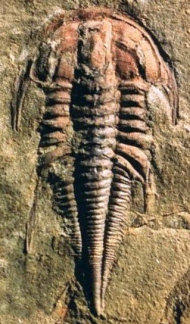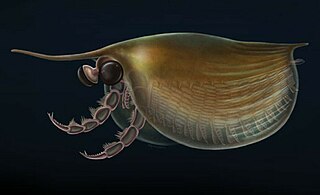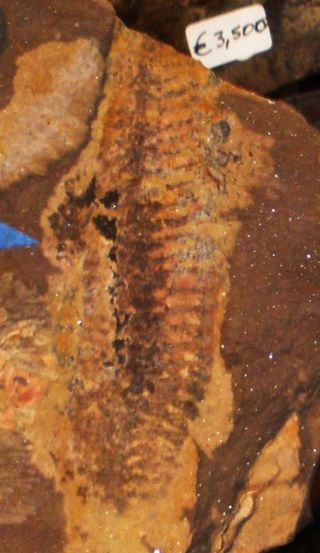
Opabinia regalis is an extinct, stem group arthropod found in the Middle Cambrian Burgess Shale Lagerstätte of British Columbia. Opabinia was a soft-bodied animal, measuring up to 7 cm in body length, and its segmented trunk had flaps along the sides and a fan-shaped tail. The head shows unusual features: five eyes, a mouth under the head and facing backwards, and a clawed proboscis that probably passed food to the mouth. Opabinia probably lived on the seafloor, using the proboscis to seek out small, soft food. Fewer than twenty good specimens have been described; 3 specimens of Opabinia are known from the Greater Phyllopod bed, where they constitute less than 0.1% of the community.

Sanctacaris is a Middle Cambrian arthropod from the Burgess Shale of British Columbia. It was most famously regarded as a stem-group chelicerate, a group which includes horseshoe crabs, spiders and scorpions, although subsequent phylogenetic studies have not always supported this conclusion. Its chelicerate affinities regain support in later observations, alongside the reassignment of Habelia optata as a sanctacaridid-related basal chelicerate. It has been placed as a member of the extinct family Sanctacarididae alongside Wisangocaris and Utahcaris.

Emuellidae are a small family of trilobites, a group of extinct marine arthropods, that lived during the late Lower Cambrian of the East Gondwana supercontinent, in what are today South-Australia and Antarctica.

Redlichia is a genus of redlichiid trilobite in the family Redlichiidae, with large to very large species. Fossils of various species are found in Lower Cambrian (Toyonian)-aged marine strata from China, Korea, Pakistan, the Himalayas, Iran, Spain, southern Siberia, and Antarctica, and from Middle Cambrian (Ordian)-aged marine strata of Australia.

The Emu Bay Shale is a geological formation in Emu Bay, South Australia, containing a major Konservat-Lagerstätte. It is one of two in the world containing Redlichiidan trilobites. The Emu Bay Shale is dated as Cambrian Series 2, Stage 4, correlated with the upper Botomian Stage of the Lower Cambrian.

Anomalocaris is an extinct genus of radiodont, an order of early-diverging stem-group arthropods.

Cheloniellida is a taxon of extinct Paleozoic arthropods. As of 2018, 7 monotypic genera of cheloniellids had been formally described, whose fossils are found in marine strata ranging from Ordovician to Devonian in age. Cheloniellida has a controversial phylogenetic position, with previous studies associated it as either a member or relative of various fossil and extant arthropod taxa. It was later accepted as a member of Vicissicaudata within Artiopoda.

Urokodia aequalis is an extinct genus of arthropod from the early Cambrian. The taxon is only known from the Maotianshan Shales of China based on some 15 specimens. Its segmentation resembles that of a millipede and it possessed head and tail shields with thorny spikes. It has some similarities to the arthropod Mollisonia that is known from both the Burgess Shale of Canada and the Kaili biota of China. Recently, the taxon has been considered a member of the order Mollisoniida, alongside Mollisonia, Thelxiope, and Corcorania, the group are suggested to be stem-chelicerates.

Megacheira is an extinct class of predatory arthropods defined by their possession of spined "great appendages". Their taxonomic position is controversial, with studies either considering them stem-group euarthropods, or stem-group chelicerates. The homology of the great appendages to the cephalic appendages of other arthropods is also controversial. Uncontested members of the group were present in marine environments worldwide from the lower to middle Cambrian.

Isoxys is a genus of extinct bivalved Cambrian arthropod; the various species of which are thought to have been freely swimming predators. It had a pair of large spherical eyes, and two large frontal appendages used to grasp prey.

Myoscolex is an early animal species known from the Cambrian Emu Bay Shale in South Australia. It was interpreted as an annelid and some supports that theory, while it was also considered as an arthropod close to Opabinia, through other studies questions that interpretation. Myoscolex is the earliest known example of phosphotized muscle tissue, and as to which shows distinct annulation.

Opabiniidae is an extinct family of marine stem-arthropods. Its type and best-known genus is Opabinia. It also contains Utaurora. Opabiniids closely resemble radiodonts, but their frontal appendages were basally fused into a proboscis. Opabiniids also distinguishable from radiodonts by setal blades covering at least part of the body flaps and serrated caudal rami.

Tegopelte gigas is a species of large soft-bodied arthropod known from two specimens from the Burgess Shale. Trackways that may have been produced by this organism or a close relative are known from the Kicking Horse Shale, stratigraphically below its body fossil occurrences. T. gigas is the only species classified under the genus Tegopelte. It is usually classified under its own family Tegopeltidae, but is sometimes placed under the family Naraoiidae. It is currently considered a member of Conciliterga within the Artiopoda.

Thelxiope is a genus of Cambrian and Ordovician arthropod. Four named species are known, the type species T. palaeothalassia is known from the Burgess Shale, Canada T. holmani is from the Wheeler Shale of Utah, Thelxiope tangi from the Linyi Lagerstätte of Shandong, China, and T. spinosa, which is known from both the Linyi Lagerstätte and the Wheeler Shale. An indeterminate species is also known from the Ordovician (Floian) Fezouata Formation in Morocco. It is a member of Mollisoniida, alongside close relatives Mollisonia, Corcorania and Urokodia. They are suggested to be stem-chelicerates.

Emucarididae is an extinct family of soft-shelled trilobite-like arthropods (nektaspids) from the Lower Cambrian of South Australia and South China. It contains only two genera – Emucaris and Kangacaris. Two species were described in 2010 from specimens recovered from Emu Bay Shale Lagerstätte, one species in 2012 from the Maotianshan Shales. It is classified under the order Nektaspida, and is a sister-group to the families Liwiidae and Naraoiidae.

Emucaris fava is an extinct species of soft-shelled trilobite-like arthropod of the nektaspid order from the Lower Cambrian of South Australia. It is the only species classified under the genus Emucaris.

Kangacaris is an extinct genus of soft-shelled trilobite-like arthropod of the nektaspid order from the Lower Cambrian (Botomian). K. zhangi is known from South Australia, and K. shui from South-West China.

Utaurora is an extinct genus of opabiniid, which were bizarre stem-arthropods closely related to true arthropods and radiodonts; the type species is U. comosa. The animal's fossils come from the Cambrian of Utah. This genus is so far the only other known unquestionable opabiniid, with the other being Opabinia itself. There are other animals like Myoscolex and Mieridduryn that could be opabiniids, but the classification of those two genera is still debated.

Oestokerkus is an extinct genus of Cambrian megacheiran arthropod known from the Emu Bay Shale of Kangaroo Island, Australia. It belongs to the family Leanchoiliidae. It had a large head shield that was more than a third of the trunk's length, as well as a large pair of eyes. The great appendages have long flagellae projecting from them. The head shield probably had two pairs of cephalic appendages. The trunk has 11 segments. The exopods of the biramous limbs are fringed with long setae. The body ended with a telson, which was probably dorsally flattened.

Echidnacaris briggsi is an extinct species of radiodont known from the Cambrian Stage 4 aged Emu Bay Shale of Australia. Formerly referred to as "Anomalocaris" briggsi, it was placed in the new monotypic genus Echidnacaris in 2023. It is only distantly related to true Anomalocaris, and is instead placed in the family Tamisiocarididae.




















